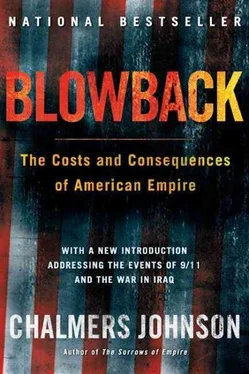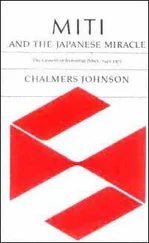Chalmers Johnson - Blowback, Second Edition - The Costs and Consequences of American Empire
Здесь есть возможность читать онлайн «Chalmers Johnson - Blowback, Second Edition - The Costs and Consequences of American Empire» весь текст электронной книги совершенно бесплатно (целиком полную версию без сокращений). В некоторых случаях можно слушать аудио, скачать через торрент в формате fb2 и присутствует краткое содержание. Год выпуска: 0101, ISBN: 0101, Издательство: Macmillan, Жанр: Старинная литература, на английском языке. Описание произведения, (предисловие) а так же отзывы посетителей доступны на портале библиотеки ЛибКат.
- Название:Blowback, Second Edition: The Costs and Consequences of American Empire
- Автор:
- Издательство:Macmillan
- Жанр:
- Год:0101
- ISBN:9780805075595
- Рейтинг книги:5 / 5. Голосов: 1
-
Избранное:Добавить в избранное
- Отзывы:
-
Ваша оценка:
- 100
- 1
- 2
- 3
- 4
- 5
Blowback, Second Edition: The Costs and Consequences of American Empire: краткое содержание, описание и аннотация
Предлагаем к чтению аннотацию, описание, краткое содержание или предисловие (зависит от того, что написал сам автор книги «Blowback, Second Edition: The Costs and Consequences of American Empire»). Если вы не нашли необходимую информацию о книге — напишите в комментариях, мы постараемся отыскать её.
Blowback, Second Edition: The Costs and Consequences of American Empire — читать онлайн бесплатно полную книгу (весь текст) целиком
Ниже представлен текст книги, разбитый по страницам. Система сохранения места последней прочитанной страницы, позволяет с удобством читать онлайн бесплатно книгу «Blowback, Second Edition: The Costs and Consequences of American Empire», без необходимости каждый раз заново искать на чём Вы остановились. Поставьте закладку, и сможете в любой момент перейти на страницу, на которой закончили чтение.
Интервал:
Закладка:
One impetus for such new, self-critical attitudes could be found in the changed economic atmosphere. Following a binge of big-ticket investments at the end of the 1980s and a bubble of real estate speculation that accompanied newfound wealth, the economy began to falter. After eight years of stagnation, in 1998 it finally plunged into real recession. In an ironic twist, American ideologists used these developments to argue as always that American free-market capitalism was the globe’s one and only path to success. However, they now incorporated revisionist analyses without acknowledgment into their critiques of the Japanese economy. For example, the Wall Street Journal’s Paul Gigot had long maintained that Japan’s economy operated just like the U.S. model. “Japan’s miracle, like Britain’s and America’s before it,” he wrote in 1986, “was largely the product of creativity and enterprise by individuals and their businesses.” 10A decade later, in a column entitled “The Great Japan Debate Is Over: Guess Who Won?,” he could be found deriding Japan’s “model of bureaucratic-led economic growth,” as distinguished from “American-style capitalism.” His new point: the revisionists may have been right about how Japan worked but they were wrong to think it was a success. To the extent that the Japanese economy might ever stage a comeback, Gigot argued in a fashion typical of his colleagues, it would have to do business “in a framework that more resembles the American model.” 11Put another way, these economic ideologues found convincing proof in Japan’s economic fate that a hegemonic America would continue to dictate the rules of international commerce into the distant future, even if that hegemony were disguised with catchphrases like “globalization.”
As the Cold War receded into history, the United States, rather than dissolving its Cold War arrangements, insisted on strengthening them as part of a renewed commitment to global hegemony. Japan was supposed to remain a satellite of the United States, whether anyone dared use that term or not. Meanwhile, annual American trade deficits with Japan soared. American manufacturing continued to be hollowed out, while a vast manufacturing overcapacity was generated in Japan and its Southeast Asian subsidiaries. Capital transfers from Japan to the United States generated huge gains for financiers and produced an illusion of prosperity in the United States, but in 1997, it all started to unravel. The most severe economic crisis since the Great Depression hit the East Asian economies and began to spread around the world.
MELTDOWN
Each year approximately ten thousand American troops descend on Thailand for a joint military exercise called Cobra Gold. The military part of these visits is largely make-work for the American and Thai staffs, but the troops love Cobra Gold because of the sex. According to the newspaper Pacific Stars and Stripes , some three thousand prostitutes wait for the sailors and marines at the South Pattaya waterfront, close to Utapao air base. An equal number of young Thai girls from the country-side, many of whom have been raped and then impressed into the “sex industry,” are available downtown in Bangkok’s Patpang district. They are virtually all infected with AIDS, but the condom-equipped American forces seem not to worry. At the time of the 1997 war games, just before the economic crisis broke, sex with a Thai prostitute cost around fifteen hundred Thai baht, or sixty dollars at its then pegged rate of twenty-five baht to one U.S. dollar. By the time of the next year’s Cobra Gold the price had been more than halved. 1This is just one of many market benefits Americans gained through their rollback operation against the “Asian model” of capitalism.
The global economic crisis that began in Thailand in July 1997 had two causes. First, the built-in contradictions of the American satellite system in East Asia had heightened to such a degree that the system itself unexpectedly began to splinter and threatened to blow apart. Second, the United States, relieved of the prudence imposed on it by the Cold War, when any American misstep was chalked up as a Soviet gain, launched a campaign to force the rest of the world to adopt its form of capitalism. This effort went under the rubric of “globalization.” As these two complex undertakings—perpetuating Cold War structures after they had lost their purpose and trying to “globalize” countries that thought they had invented a different kind of capitalism—played themselves out around the world, they threatened a worldwide collapse of demand and a new depression. Whatever happens, the crisis probably signaled the beginning of the end of the American empire and a shift to a tripolar world in which the United States, Europe, and East Asia simultaneously share power and compete for it.
During the Cold War, the Communists routinely charged that the United States used the Marshall Plan for rebuilding wartorn Europe and subsequent economic aid programs to advance the interests of American companies and to keep the Third World dependent on the First. According to the Communist theory of economic colonialism, capitalist states enforce an inherently discriminatory division of labor on less developed countries by selling them manufactured goods and buying from them only raw materials, an extremely profitable arrangement for capitalists in advanced countries and one that certainly keeps underdeveloped countries underdeveloped. This is why revolutionary movements in underdeveloped countries want either to overthrow the capitalist order or to industrialize their economies as fast as possible.
Such economic colonialism has long existed in many aspects of America’s relations with Latin America. During the Cold War, the United States wrapped this system of dependency in the rhetoric of anticommunism, labeling elected leaders Communists if they seemed to endanger American corporate interests, as in Guatemala in 1954, and ordering the CIA to overthrow them. Campaigns against the influence of Fidel Castro, for instance, often proved of great usefulness to American companies south of the border. But this pattern of relationships did not cause the global economic crisis of the late 1990s.
The fundamental structural cause was the way the United States for more than forty years won and retained the loyalty of its East Asian satellites. These non-Communist countries accepted the American deal as offered and worked hard at “export-led growth,” primarily to the American market. If the Japanese led this movement, behind them were three ranks of followers: first, the “newly industrialized countries” of South Korea, Taiwan, Hong Kong, and Singapore; then, the late developers of Southeast Asia, Malaysia, Indonesia, Thailand, and the Philippines; and finally, China, at present the world’s fastest-growing economy. The Japanese found this so-called flying-geese pattern appealing. They were flattered to be the lead goose and the inspiration for those that followed. The leaders of each of these countries assumed that their economic destination—Los Angeles (and from there the rest of the American market)—was a permanent feature of the international environment; and so long as the Cold War existed, it was as permanent as anything ever is in interstate relations.
Over time, however, this pattern produced gross overinvestment and excess capacity in East Asia, the world’s largest trade deficits in the United States, and a lack of even an approximation of supply-and-demand equilibrium across the Pacific. Contrary to Communist analyses of how neocolonialism should work, these terms proved surprisingly costly to the imperial power. They cost American jobs, destroyed manufacturing industries, and blunted the hopes of minorities and women trying to escape from poverty.
Читать дальшеИнтервал:
Закладка:
Похожие книги на «Blowback, Second Edition: The Costs and Consequences of American Empire»
Представляем Вашему вниманию похожие книги на «Blowback, Second Edition: The Costs and Consequences of American Empire» списком для выбора. Мы отобрали схожую по названию и смыслу литературу в надежде предоставить читателям больше вариантов отыскать новые, интересные, ещё непрочитанные произведения.
Обсуждение, отзывы о книге «Blowback, Second Edition: The Costs and Consequences of American Empire» и просто собственные мнения читателей. Оставьте ваши комментарии, напишите, что Вы думаете о произведении, его смысле или главных героях. Укажите что конкретно понравилось, а что нет, и почему Вы так считаете.










